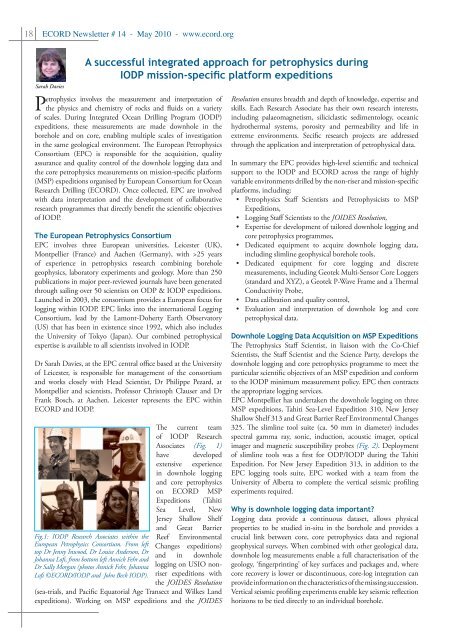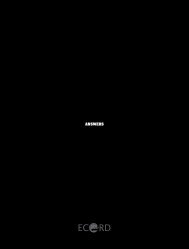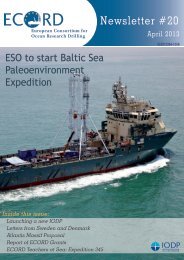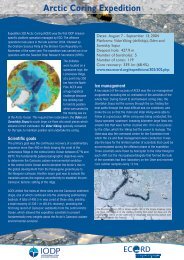14 - European Consortium for Ocean Research Drilling
14 - European Consortium for Ocean Research Drilling
14 - European Consortium for Ocean Research Drilling
- No tags were found...
Create successful ePaper yourself
Turn your PDF publications into a flip-book with our unique Google optimized e-Paper software.
18 ECORD Newsletter # <strong>14</strong> - May 2010 - www.ecord.orgSarah DaviesA successful integrated approach <strong>for</strong> petrophysics duringIODP mission-specific plat<strong>for</strong>m expeditionsPetrophysics involves the measurement and interpretation ofthe physics and chemistry of rocks and fluids on a varietyof scales. During Integrated <strong>Ocean</strong> <strong>Drilling</strong> Program (IODP)expeditions, these measurements are made downhole in theborehole and on core, enabling multiple scales of investigationin the same geological environment. The <strong>European</strong> Petrophysics<strong>Consortium</strong> (EPC) is responsible <strong>for</strong> the acquisition, qualityassurance and quality control of the downhole logging data andthe core petrophysics measurements on mission-specific plat<strong>for</strong>m(MSP) expeditions organised by <strong>European</strong> <strong>Consortium</strong> <strong>for</strong> <strong>Ocean</strong><strong>Research</strong> <strong>Drilling</strong> (ECORD). Once collected, EPC are involvedwith data interpretation and the development of collaborativeresearch programmes that directly benefit the scientific objectivesof IODP.The <strong>European</strong> Petrophysics <strong>Consortium</strong>EPC involves three <strong>European</strong> universities, Leicester (UK),Montpellier (France) and Aachen (Germany), with >25 yearsof experience in petrophysics research combining boreholegeophysics, laboratory experiments and geology. More than 250publications in major peer-reviewed journals have been generatedthrough sailing over 50 scientists on ODP & IODP expeditions.Launched in 2003, the consortium provides a <strong>European</strong> focus <strong>for</strong>logging within IODP. EPC links into the international Logging<strong>Consortium</strong>, lead by the Lamont-Doherty Earth Observatory(US) that has been in existence since 1992, which also includesthe University of Tokyo (Japan). Our combined petrophysicalexpertise is available to all scientists involved in IODP.Dr Sarah Davies, at the EPC central office based at the Universityof Leicester, is responsible <strong>for</strong> management of the consortiumand works closely with Head Scientist, Dr Philippe Pezard, atMontpellier and scientists, Professor Christoph Clauser and DrFrank Bosch, at Aachen. Leicester represents the EPC withinECORD and IODP.Fig.1: IODP <strong>Research</strong> Associates within the<strong>European</strong> Petrophysics <strong>Consortium</strong>. From lefttop Dr Jenny Inwood, Dr Louise Anderson, DrJohanna Lofi, from bottom left Annick Fehr andDr Sally Morgan (photos Annick Fehr, JohannaLofi ©ECORD/IODP and John Beck IODP).The current teamof IODP <strong>Research</strong>Associates (Fig. 1)have developedextensive experiencein downhole loggingand core petrophysicson ECORD MSPExpeditions (TahitiSea Level, NewJersey Shallow Shelfand Great BarrierReef EnvironmentalChanges expeditions)and in downholelogging on USIO nonriserexpeditions withthe JOIDES Resolution(sea-trials, and Pacific Equatorial Age Transect and Wilkes Landexpeditions). Working on MSP expeditions and the JOIDESResolution ensures breadth and depth of knowledge, expertise andskills. Each <strong>Research</strong> Associate has their own research interests,including palaeomagnetism, siliciclastic sedimentology, oceanichydrothermal systems, porosity and permeability and life inextreme environments. Secific research projects are addressedthrough the application and interpretation of petrophysical data.In summary the EPC provides high-level scientific and technicalsupport to the IODP and ECORD across the range of highlyvariable environments drilled by the non-riser and mission-specificplat<strong>for</strong>ms, including:• Petrophysics Staff Scientists and Petrophysicists to MSPExpeditions,• Logging Staff Scientists to the JOIDES Resolution,• Expertise <strong>for</strong> development of tailored downhole logging andcore petrophysics programmes,• Dedicated equipment to acquire downhole logging data,including slimline geophysical borehole tools,• Dedicated equipment <strong>for</strong> core logging and discretemeasurements, including Geotek Multi-Sensor Core Loggers(standard and XYZ), a Geotek P-Wave Frame and a ThermalConductivity Probe,• Data calibration and quality control,• Evaluation and interpretation of downhole log and corepetrophysical data.Downhole Logging Data Acquisition on MSP ExpeditionsThe Petrophysics Staff Scientist, in liaison with the Co-ChiefScientists, the Staff Scientist and the Science Party, develops thedownhole logging and core petrophysics programme to meet theparticular scientific objectives of an MSP expedition and con<strong>for</strong>mto the IODP minimum measurement policy. EPC then contractsthe appropriate logging services.EPC Montpellier has undertaken the downhole logging on threeMSP expeditions, Tahiti Sea-Level Expedition 310, New JerseyShallow Shelf 313 and Great Barrier Reef Environmental Changes325. The slimline tool suite (ca. 50 mm in diameter) includesspectral gamma ray, sonic, induction, acoustic imager, opticalimager and magnetic susceptibility probes (Fig. 2). Deploymentof slimline tools was a first <strong>for</strong> ODP/IODP during the TahitiExpedition. For New Jersey Expedition 313, in addition to theEPC logging tools suite, EPC worked with a team from theUniversity of Alberta to complete the vertical seismic profilingexperiments required.Why is downhole logging data important?Logging data provide a continuous dataset, allows physicalproperties to be studied in-situ in the borehole and provides acrucial link between core, core petrophysics data and regionalgeophysical surveys. When combined with other geological data,downhole log measurements enable a full characterisation of thegeology, ‘fingerprinting’ of key surfaces and packages and, wherecore recovery is lower or discontinuous, core-log integration canprovide in<strong>for</strong>mation on the characteristics of the missing succession.Vertical seismic profiling experiments enable key seismic reflectionhorizons to be tied directly to an individual borehole.







